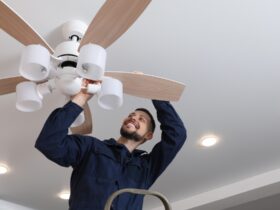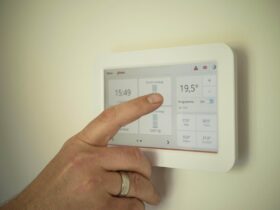Let’s be honest—owning a home is rewarding, but what about the upkeep? Not so much. Between cleaning, fixing, and replacing things, it can feel like the work never ends. That’s why more people are thinking long-term when building a new home. They don’t just want something that looks good. They want a house that’s smartly built, easy to take care of, and built to last.
In places like Hendersonville, TN, where the weather shifts from hot summers to chilly winters, maintenance can get even more demanding. That’s why it makes sense to plan ahead. When you build a home that’s low-maintenance from the beginning, you save time, money, and energy down the road. Whether you’re working with a builder or doing it yourself, here are the key things to think about.
Pick Smart Heating and Cooling Systems
A home’s heating and cooling system has a big impact on both comfort and upkeep. If you want a low-maintenance home, this is one of the smartest places to focus.
Not all HVAC systems are built the same. The better the setup, the fewer surprises you’ll run into later. This is especially important in areas with changing seasons. If you’re building a home in this region, it helps to work with experts who know the local climate. For example, there are reliable heating and cooling services in Hendersonville, TN, that can guide you through your options and make sure your system fits your home’s needs.
Choosing a good system upfront reduces the need for repairs and keeps your home running smoothly without a lot of extra effort.
Choose the Right Materials from the Start
What you build with matters. The materials you choose will shape how much you’ll need to clean, repair, or replace things later. Some materials just last longer and require less effort.
Siding is a good place to start. Fiber cement and vinyl siding both stand up well to sun, rain, and pests. Unlike wood, they don’t need to be painted every few years, and they won’t rot or warp.
Roofing also plays a big role in long-term maintenance. Metal roofs are more durable than asphalt shingles and can last 40–70 years. They don’t crack or curl, and they hold up better in storms.
Flooring should also be easy to clean and hard to damage. Luxury vinyl plank flooring is a popular pick because it’s waterproof and scratch-resistant. Polished concrete is another strong choice, especially for modern homes.
Countertops and cabinets should be built to handle daily use without special treatment. Quartz countertops are non-porous, so they don’t need to be sealed. They also resist stains and bacteria, making cleanup a breeze.
It’s also worth checking warranties when you shop for materials. Long warranties usually mean longer life and fewer headaches.
Go for Durable Finishes That Don’t Show Wear
You’ll touch and see your home’s surfaces every day. Some finishes hold up better than others, and the ones that do will save you time on cleaning and upkeep.
- For your walls, matte or satin paint finishes work well in most rooms. They hide scuffs and fingerprints better than glossy finishes. If you have kids or pets, this can be a game-changer.
- In bathrooms and kitchens, look for tiles with darker grout. Light grout tends to stain quickly and needs regular scrubbing. Dark grout hides dirt and lasts longer without needing attention.
- When choosing door handles, faucets, and cabinet hardware, darker finishes like matte black or oil-rubbed bronze tend to show fewer smudges. They also blend well with most home styles.
Little choices like these add up. The more durable the finish, the less time you’ll spend wiping it down or fixing it later.
Design Spaces That Are Easy to Clean
The way a house is laid out affects how easy it is to keep clean. Smart design goes a long way when your goal is low-maintenance living.
Avoid fancy trim or molding that collects dust. Choose smooth walls and clean lines. The fewer tight corners you have, the less you’ll need to reach or bend to clean.
Open floor plans with fewer walls and hallways feel more spacious and are easier to maintain. Built-in storage is another great addition. Shelves, benches, and closets that are part of the home’s structure don’t shift around or collect as much dust as freestanding furniture.
In bathrooms, walk-in showers with frameless glass are easier to clean than tubs with shower curtains. Add shelving inside walls instead of bulky shower caddies.
Good storage is key, too. A home with organized storage spaces helps you stay clutter-free without trying. Think built-in pantry shelves, linen closets, and garage storage systems.
Plan for the Outdoors, Too
The outside of your home deserves just as much thought. Landscaping and outdoor features can be high-maintenance if you’re not careful.
- Native plants are one of the best choices for easy landscaping. They’re adapted to local conditions, so they need less watering, fertilizer, or attention.
- If you want to skip mowing, think about using gravel, stone, or mulch beds in place of a traditional lawn. These look clean and tidy with very little effort.
- Composite decking is a smart swap for wood. It doesn’t splinter, fade, or need sealing. It also holds up well in rain and sun.
- Drip irrigation systems water plants right at the roots and reduce waste. You can set them up on timers and forget about daily watering.
A simple outdoor design can still look great—without adding to your chore list.
Include Energy-Efficient Fixtures and Appliances
Energy-efficient homes tend to require less upkeep. That’s because the systems are built to perform well with fewer breakdowns.
LED lighting lasts for years without needing replacement. Install them in hard-to-reach places so you don’t have to keep dragging out the ladder.
Tankless water heaters are another great choice. They last longer than traditional models and take up less space.
Look for ENERGY STAR appliances when choosing washers, dryers, dishwashers, and fridges. These are tested for quality and use less power and water.
Also, pick simple designs over flashy ones. Appliances with fewer moving parts usually mean fewer repairs. Function beats fancy every time.
Building a low-maintenance home doesn’t mean settling for less. It means making smart choices with your future in mind. By focusing on easy-care materials, thoughtful design, and efficient systems, you can create a space that works for you—not the other way around. Take time to plan it right, and you’ll thank yourself every day you don’t have to fix, clean, or replace something.







Leave a Reply